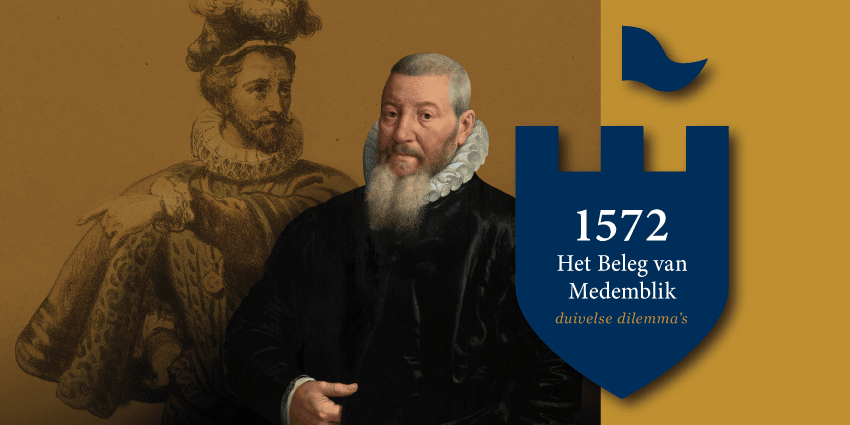Throughout the centuries, Radboud Castle has been under siege more than once. We like to tell you those stories. In 2022 we celebrate 450 years of the Netherlands, 1572 is considered our 'year of birth'. That is why we start with the siege of that year.
The Dutch Revolt, also known as the Eighty Years' War, is still in its infancy, but the rebels gain a foothold in several places in 1572. Medemblik's strategic location on the then Zuiderzee made it a very important town at the time. Records from the West Frisian archives, among others, show that Radboud Castle was the center of a battle in 1572. What exactly was going on?
1566-1568: run-up to a revolt
To know how it began, let's go back to 1566. The Low Countries are under the Spanish kingdom. The Spanish king Philip II is Catholic, but by now the Reformation is underway and more and more people in the Low Countries are Protestant. Until then, the Dutch nobility has quite a bit of freedom to govern their territories as they see fit. But Philip wants everything centralized again and imposes more and more rules, especially on religion. The Spanish Inquisition persecutes anyone who is not a neat Catholic.
Plea of the Nobles
The Dutch nobles did not like this and wanted their freedoms back. Therefore, on April 5, 1566, they offered the plea of the nobles, in which they asked for religious freedom, among other things. If not, there would be an uprising. They were not laughed out of court; the Spanish nobility saw the Dutch as 'des gueux', or vagrants.
Iconoclasm and the response of Philip
Archduchess Margaret of Parma, half-sister of Philip, is of the piecemeal variety and promises to halt the Inquisition until she has an answer from Philip. With that, she gives a finger; the Protestants grab the whole hand. The Iconoclasm is the result.
In response, Philip sends the Duke of Alva. He proceeds with a heavy hand. The Dutch nobility fled abroad and, as threatened, revolted. In 1568, they make several raids on the Dutch-German border. The Battle of Heiligerlee is the first the Beggars win. The Eighty Years' War, or Dutch Revolt is officially underway.
Lucky accident: Den Briel in hands of the Beggars thanks to storm
In 1572, the Eighty Years' War has been going on for four years, and things are not yet going well for the insurgents. They are not yet well organized, and do not yet have a good strategy. The Oranges are kind of in charge, but there are several prominent Beggars. One is Willem van der Marck Lumey, who is planning an attack on Enkhuizen from England.
So said, so done, you might say, but no. Lumey and his crew run into a storm and land not in North Holland, but South Holland, near Den Briel (Brielle). The city turns out to be poorly guarded and on April 1, 1572, the Beggars attack. With success, Den Briel is the first city to fall into the hands of the insurgents."
The battle in West Friesland
Lumey works closely with Diederik van Sonoy. The latter was appointed governor of North Holland and Waterland by William of Orange. Would he then immediately make sure that these regions joined Orange. Quite a task, especially since Van Sonoy is still at his escape address in Germany.
Van Sonoy and Lumey are known to use brute force. They do the same in West Friesland. In the villages in the countryside churches are plundered and farmers robbed of their supplies. Under this threat, a number of towns were forced to join the Beggars, hoping to spare their inhabitants such violence. But there are also those who voluntarily support the rebellion. Enkhuizen for example: in May 1572 the inhabitants decide to speak out for Orange and imprison the town council. As soon as Van Sonoy hears this, he leaves in a hurry for Enkhuizen, to annex the rest of North Holland as well.
The siege of Medemblik
Medemblik is Spanish-speaking in 1572. Kastelein Cornelis van Rijswijk, boss of Radboud Castle, is an old hand in the trade with some 20 years of experience. He has no problems with the Spaniards. Indeed, Spain has waived part of the tax so that Medemblik can rebuild the burned Bonifacius Church.
Therefore, when in June of that year Van Sonoy and Jacob Cabeliau stood at the gate, Van Rijswijk sent them away empty-handed. He has no intention of joining the revolt.
A few days later, Cabeliau and his Beggars attack Medemblik. The town guards flee to the castle, as do many Medemblikkers. But Cabeliau did not give up and besieged the castle.
At first, Van Rijswijk is not worried. The castle is well defended and has survived sieges before. But he has not taken into account the tenacity of Cabeliau. He does not give up easily.
Both men face a diabolical dilemma. Cabeliau is faced with the choice: Do I attack the castle with my men or do I take advantage of the Medemblikans that I can get my hands on? For Van Rijswijk the question is: What will I do to keep the castle for my king?
You will find the answers to these questions in the exhibition '1572: The Siege of Medemblik'. Here you will face the same dilemmas as the Beggars and the Medemblickers at the time. What would you do?
'1572: The Siege of Medemblik' is on view from April 2022 through Jan. 8, 2023

